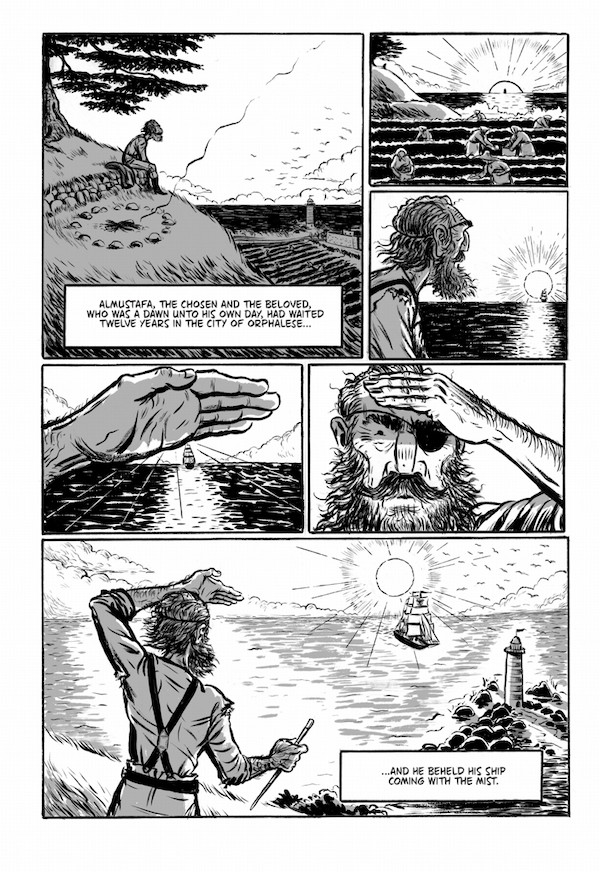The following is an interview with A. David Lewis regarding the release of the graphic novel adaptation of Kahlil Gibran’s The Prophet with Graphic Mundi. In this interview, Fanbase Press Editor-in-Chief Barbra Dillon chats with Lewis about the shared creative process of adapting the work alongside artist Justin Rentería, what he hopes that readers may take away from the story, and more!
Barbra Dillon, Fanbase Press Editor-in-Chief: Congratulations on your adaptation of The Prophet! As one of the best know works of free-verse poetry, what are you most excited for readers to experience with this adaptation?
A. David Lewis: It has to be Justin’s art, frankly. I was incredibly fortunate not only to be introduced to his talent but also for him already having a personal connection to the work. He really made the ideas I had for Gibran’s work come alive, and he shared the same respect I had for the original text. It’s not often that you get a collaborator with whom you gel so nicely, so that makes me particularly excited for people to experience the poem through his masterfully (and well-researched) illustrations.
BD: The creative process of approaching an adaptation of a prior work – especially one as well known as The Prophet – can be a daunting experience. How would you describe your approach to breathing new life into the story alongside artist Justin Rentería, and what did you find to be most rewarding/challenging about the process?
ADL: Both Justin and I did extensive research before diving into this endeavor. I know that he delved into the costume and architecture of the Ottomon empire and surrounding areas of the Mediterranean in our effort to have the story retain its ‘timeless’ quality. For my part, I read everything on Gibran that I could and tried to understand the context from which the poem emerged for him. Additionally, I visited the Gibran Memorial here in Boston, and I looked through much of his own art.
I like to think that Gibran himself would approve of comics as a medium, but easily the most difficult part of this project was balancing the inclusion of his verse with illustrated interpretations of it. It was a very fine line to walk, since I didn’t want us to disrupt any flow or message of the original work, but I still wanted to utilize all the tools and techniques of comics. The most rewarding aspect of this endeavor is to hear from people who either discovered or rediscovered Gibran’s genius through these efforts.
BD: What makes Graphic Mundi the perfect home for this story?
ADL: Graphic Mundi has an academic publisher’s backbone, having originated with Penn State Press. I was already impressed with PSP, particularly its graphic medicine output, so hearing that they were fashioning a trade publishing imprint left me very excited. I tend to favor new and fledgling publishers rather than those who have a house style or established set of expectations. What made Graphic Mundi so attractive was its experience as a scholarly publisher combined with its new goals in the trade market. I liked the ambition this showed but also the know-how it had already acquired. Moreover, I think our aim to make this an adaptation of The Prophet, something that’s rarely been attempted, fit nicely with their varied catalogue; it delighted me to think of it alongside graphic memoirs like Marry Me a Little or comics journalism like Nuking Alaska. These motivated titles were exactly the company I wanted us to be in.

BD: At Fanbase Press, our #StoriesMatter initiative endeavors to highlight the impact that stories can have on audiences of various mediums. Given that this adaptation is finding its release exactly 100 years after the story’s original publication, how do you feel that The Prophet’s story will connect with and impact today’s readers?
ADL: I’m hoping there’s a universality to it that, partly, restores people’s faith in our all being connected. Across the world and particularly here in the U.S., life has become so polarized, with people siloed off from each other and finding alternate opinions not just alien but offensive. I am staunchly in the camp of finding the humanity in everyone, even the most flawed or hateful, and that, personally, can be difficult to maintain sometimes. The Prophet was a poem that would help in fanning that low flame for me, as I think it has for many over the course of the last century. Gibran established such a wonderful and embracing ethos, one that acknowledges humanity’s flaws and folly, that I desire our adaptation to echo.
BD: Are there any other upcoming projects on which you are currently working that you would like to share with our readers?
ADL: The pandemic sidelined not only my other creative projects but also my academic work. So, while I remain undecided about my next comics venture, I do plan to complete my overdue manuscript on the connection between religion and medicine in comics. The working title is Body, Soul, and Comics, and I’d like to have it to the publisher before the year’s end.
I should also mention that Justin is doing some really fun work of his own: People should follow his Instagram account (@el_justo_draws), where he’s sharing excerpts and behind-the-scenes samples of his series, That Rufus Karl Is One Bad Hombre. It’s terrific!
BD: Lastly, what is the best way for our readers to find more information about The Prophet and your other work?
ADL: I’m also on Instagram as @a.davidlewis. With Twitter – ahem, X – sadly dying, I can most easily be found at ADavidLewis.com, and a number of my books are available on Amazon and Bookshop.com.

